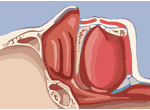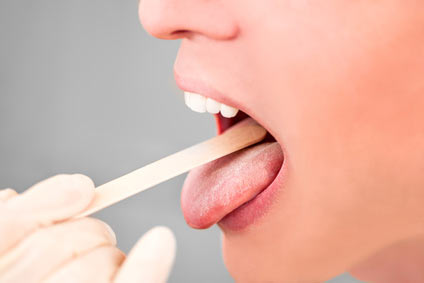Turbinate Reduction Surgery
Treating Sleep Apnea with Turbinate Reduction

In this page you'll discover how can a nose surgery, such as turbinate reduction, can improve obstructive sleep apnea.
Nose surgery is very often the first therapeutic choice in the treatment of obstructive sleep apnea.
With nose surgery we understand:
- reduction of the turbinates,
- plastic surgery of the septum,
- rhinoseptoplasty,
- functional endoscopic sinus surgery (FESS).
The purpose of nasal surgery is to provide the patient with a free nasal airway during sleep, and if you have an obstruction of your airflow due to enlarged turbinates or deviation of the septum, then nasal surgery is recommended.
What Are The Turbinates?
The turbinates have an important role in terms of directing and controlling airflow and maintaining healthy nasal functions, such as:
- they help filter the air so that particles don't go down directly into the lungs,
- as the air flows past the turbinates, the air is warmed up and humidified so that once the air gets to the lungs, it is more comfortable,
- the nervous system from the turbinates helps you feel how much air you have taken in (without turbinates you may feel that you're not getting enough air, even if there is no blockage at all),
Because the turbinates have such an important role, you don't want to be completely removed with surgery (turbinectomy), but only reduced, so that you can breathe normally again.
Click here to see how an enlarged turbinate can affect your breathing through obstruction (very interesting).
Causes of Enlarged Turbinates
Turbinates normally become enlarged or congested for several reasons, such as:
- allergies,
- change of weather,
- different types of food,
- hormonal changes,
- persistent sinus inflammation,
- hormonal changes,
- stress,
- deviated septum,
- environmental irritants (cigar smoke),
- aging.
Turbinate Reduction Surgery Procedures
The procedure is performed in a hospital ambulatory surgical center, it takes approximately one hour and is performed under general anesthesia.
Although nasal packing (placing sponges in the nose for several days after the operation) is often used by many surgeons, it is usually unnecessary.
The surgery is generally associated with a mild amount of discomfort, but it can be easily managed with medications for one to two days.
If you have moderate or severe nasal obstruction, an overnight hospitalization is recommended. Because you will experience nasal stuffiness for a few days after surgery, you can usually return to work in three days.
Coblation Turbinate Reduction
Coblation is an advanced technology where the surgeon can quickly remove and shrink the tissues from inside the nasal turbinates. The tissue is removed with a special device that is gently inserted without causing pain or bleeding.
Another advantage from coblation surgery is that you don't need to receive general anesthesia.
In this animation you'll see what happens inside the nose during the coblation surgery for turbinate reduction:
 Coblation Turbinate Reduction Animation
Coblation Turbinate Reduction Animation
If coblation surgery sounds appealing for you, then you may want to check the next video, where the surgeon operates live a patient:
 Turbinate Reduction Procedure Using Coblation
Turbinate Reduction Procedure Using Coblation
Radiofrequency Treatment of Nasal Turbinates
Another procedure for reduction of nasal turbinates is radiofrequency treatment, also called radiofrequency ablation, which has a significant advantage from the classical surgery:
- precision targeting tissue,
- minimal tissue injury and complication,
- local anesthesia,
- minimal pain.
This video explains more about turbinates and radiofrequency ablation:
 Radiofrequency ablation for nasal turbinates
Radiofrequency ablation for nasal turbinates
The benefit of radiofrequency treatment of nasal turbinates is that minimal discomfort is generally experienced during the procedure, and there is no restriction in activity after treatment. So you can go to work in the same day.
Just remember that you will experience nasal stuffiness for three to five days, and the healing process takes longer (one to three weeks) where scar tissue forms, causing the tissue to shrink to increase the airway space.
Turbinate Reduction for Sleep Apnea
This nasal surgery is not likely to cure anyone of sleep apnea, because with OSA the blockage is usually in the area of the back of the tongue and the soft palate. However, sleep quality and daytime fatigue frequently improve in patients with nasal obstruction (with or without obstructive apnea).
Furthermore, nasal surgery, is commonly used to improve CPAP therapy, and especially nasal CPAP ventilation. After the surgery, the reduction of nasal resistance significantly increases the compliance of CPAP, which is a great news for patients with sleep apnea and nasal obstruction.
One important aspect in nasal obstruction: it's very interesting how much the nasal passages affects sleep apnea. If the nose is congested, less air will be taken in and gradually causes a suctioning effect which makes the airway to close.
This phenomenon also forces you to breathe through your mouth, which is not recommended if you have nasal CPAP mask or CPAP pillows.
To avoid using a full face mask, which is difficult to tolerate for many users, I recommended to check if your turbinates are enlarged or if you have deviated septum. The nasal surgery will make your CPAP therapy much easier.







